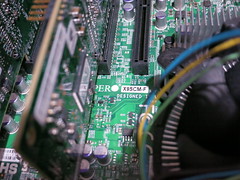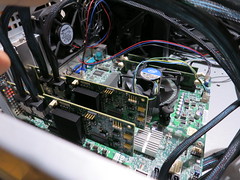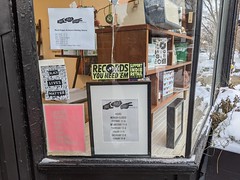from outside
These are things pulled in here or pushed to here from other sources.
Norco DS-24H
<a href="https://www.flickr.com/people/nullrend/">nullrend</a> posted a video:
 Turning it on with all the fans installed at the factory. It's loud.
Turning it on with all the fans installed at the factory. It's loud.
Frames, ships. All carry payloads
About an hour ago I found this article explaining how shippers went for even bigger ships than before, thinking economies of scale would help them make more money.
Then I read this other article about how the Port of Los Angeles is buckling under pressure by having multiple container ships at berth. The Port of New York City also reports taking on bigger ships.
I’m thinking in networking terms but
- Bigger container ships
==Ethernet Jumbo frames - Global shipping routes
==Internet - Ports
==Network gateways
The challenges with jumbo frames are well known. Some people hate them, others say use them with care. It all comes down to what you’re trying to do and what your equipment supports.
If you have a route across the Internet and every node between the starting point and the end point support jumbo frames, you’re set. If not, you can keep them disabled and still reap 90% of the benefits.
This is not so with actual physical matter being transported via ships. Ports can’t be replaced in a few weeks or months. Expansion of a port often takes years (NYC, LA, Duluth) and costs can run into hundreds of millions of dollars. You can’t exacly load balance across ports while you upgrade one the way you can with a network gateway. In this context, extra-jumbo container ships give rise to bursts of frantic activity at ports to get them unloaded, when the entire system relies on port activity being steady.
Add in the COVID-19 pandemic and burst activity will facilitate virus spread throughout port workers. None of this is a good combination. Wonder if there are any studies that apply IP networking concepts to the study of seafaring shipping?
Also, governments seriously need to look at how the shipping cartels operate. Cos that’s what they are, cartels.
The more things change the more they stay the same
20 years in, blogging is still a curious mix of both technical, literary and graphic bodgery, with each day’s work demanding the kind of technical minutuae we were told would disappear with WYSIWYG desktop publishing.
Source: Pluralistic: 13 Jan 2021 – Pluralistic: Daily links from Cory Doctorow
20 years from now blogging will still be a mix of technical, literary, and graphic bodgery.
Venture Capital is a plague
Allowing masses of underpaid workers to be exploited in order to provide widespread convenience was always a depraved bargain, built on a rickety ethical and economic foundation.
Source: Instacart Is a Parasite and a Sham | The New Republic
This industry is ripe for some entity to come out with a co-op model where drivers are not only the employees making the delivery, but also owner shareholders in the company. No one will get rich quickly but they’d earn substantially more than poverty wages.
The “uber but for x” economic model is reliant on destroying everything around it so VC can get rich. Hopefully we won’t need 50 years to gig economy doesn’t work, just like trickle-down economics.
Fuck venture capital, really
It’s almost poetic that the debate over .ORG reached a climax just as COVID-19 was becoming a worldwide crisis. Emergencies like this one are when the world most relies on nonprofits and NGOs; therefore, they’re also pressure tests for the sector. The crisis demonstrated that the NGO community doesn’t need fancy “products and services” from a domain registry: it needs simple, reliable, boring service. Those same members of Congress who’d scrutinized the .ORG sale wrote a more pointed letter to ICANN in March (PDF), plainly noting that there was no way that Ethos Capital could make a profit on its investment without making major changes at the expense of .ORG users.
Source: How We Saved .ORG: 2020 in Review | Electronic Frontier Foundation
Domain ownership should be a boring enterprise now that the age where you could get rich just by selling domains is past. You can do price speculation but that is another thing entirely.
Pushing on “products and services” is how we ended up with GoDaddy, which time and time again has proved to be a shitty company to do business with and to work for.
We don’t need any companies like GoDaddy running .ORG, much less venture capital.
Why would I take LinkedIn seriously anyway?
Every platform has its royalty. On Instagram it’s influencers, foodies, and photographers. Twitter belongs to the founders, journalists, celebrities, and comedians. On LinkedIn, it’s hiring managers, recruiters, and business owners who hold power on the platform and have the ear of the people. The depravity of a platform where HR Managers are the rockstars speaks for itself.
Source: LinkedIn’s Alternate Universe – Divinations
My job listings on LinkedIn:
- Get yelled at by customers
- Drink coffee
- ?????
- Get yelled at by the boss
- Boredom
This is a social network for HR and godinez types.
In the olden days they used to call it indentured servitude
I still use ride hailing and food delivery services, but the fact is that the core functionality of these apps — despite all their fancy technology — is not significantly different than having a servant. What the technology has done is pool the servants, make them available to more people, make it easier to communicate tasks, and — most importantly — make it possible to not think of them as servants at all.
Source: The Gig Economy Is White People Discovering Servants | by Indi Samarajiva | Medium
When you don’t think of people as your servant you don’t have to think about the implications of servitude— including the linguistics of it, like “master”, “servant”, or “honor”. How long before people find themselves finding themselves in “exclusive contracts” with a specific gig agency?
The Racist Legacy of Computer-Generated Humans – Scientific American
The technological white supremacy extends to human hair, where the term “hair” has become shorthand for the visual features that dominate white people’s hair. The standard model for rendering hair, the “Marschner” model, was custom-designed to capture the subtle glints that appear when light interacts with the micro-structures in flat, straight hair. No equivalent micro-structural model has ever been developed for kinky, Afro-textured hair. In practice, the straight-hair model just gets applied as a good-enough hand-me-down.
Source: The Racist Legacy of Computer-Generated Humans – Scientific American
Pixar continues this in their latest film: an epic to the Magical Negro trope, where the Black person isn’t portrayed as black for most of the film but rather as a blue blob.











